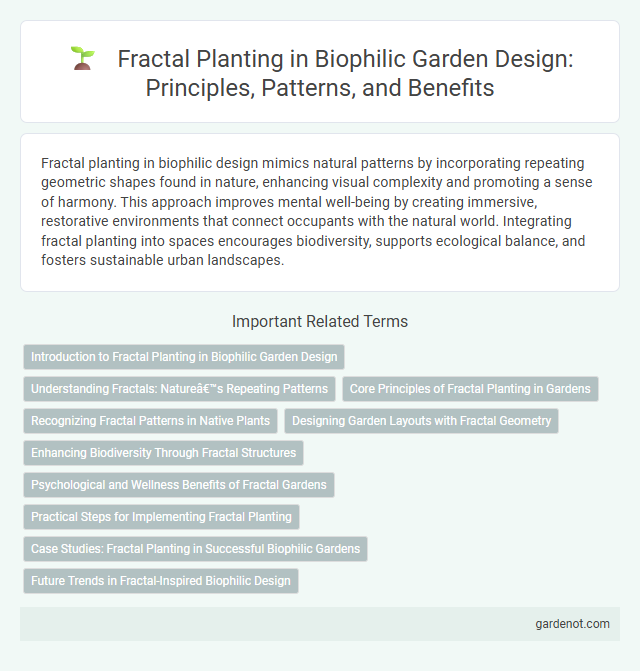Fractal planting in biophilic design mimics natural patterns by incorporating repeating geometric shapes found in nature, enhancing visual complexity and promoting a sense of harmony. This approach improves mental well-being by creating immersive, restorative environments that connect occupants with the natural world. Integrating fractal planting into spaces encourages biodiversity, supports ecological balance, and fosters sustainable urban landscapes.
Introduction to Fractal Planting in Biophilic Garden Design
Fractal planting in biophilic garden design utilizes repeating natural patterns that mimic the complexity found in ecosystems, enhancing visual harmony and ecological function. This approach integrates scalable plant arrangements that promote biodiversity while fostering psychological well-being through nature's inherent fractal geometry. By reflecting fractal principles, gardens create immersive, dynamic environments that strengthen human-nature connections.
Understanding Fractals: Nature’s Repeating Patterns
Fractal planting leverages nature's inherent repeating patterns, where smaller plant structures mimic the shape of larger formations, creating a visually cohesive ecosystem. Understanding fractals reveals how these self-similar designs enhance biodiversity and promote natural growth cycles, fostering resilience in garden environments. Incorporating fractal principles in landscaping encourages harmony between built spaces and natural elements, improving aesthetic appeal and psychological well-being.
Core Principles of Fractal Planting in Gardens
Fractal planting in gardens emphasizes repeating patterns at various scales, mimicking natural growth to create visually harmonious landscapes. Core principles include self-similarity, where plant groupings replicate overarching shapes, and scale invariance, ensuring patterns are recognizable whether viewed up close or from afar. This approach enhances biodiversity and psychological well-being by fostering organic complexity and natural rhythm.
Recognizing Fractal Patterns in Native Plants
Recognizing fractal patterns in native plants enhances biophilic design by mimicking natural growth structures that promote visual harmony and ecological stability. These repeating self-similar patterns improve environmental connection and support biodiversity by creating habitats aligned with local flora characteristics. Integrating fractal planting with native species fosters sustainable landscapes that resonate with innate human preferences for natural complexity and order.
Designing Garden Layouts with Fractal Geometry
Fractal planting leverages the principles of fractal geometry to create garden layouts that mimic natural patterns, enhancing visual harmony and biodiversity. By arranging plants in recursive, self-similar patterns, designers optimize space utilization and promote ecological balance. This approach fosters seamless integration between built environments and nature, resulting in aesthetically pleasing and sustainable landscapes.
Enhancing Biodiversity Through Fractal Structures
Fractal planting leverages naturally repeating geometric patterns to create diverse microhabitats, significantly enhancing urban biodiversity. This approach mimics natural ecosystems by fostering various plant layers and spatial scales, promoting insect pollinators, birds, and soil microorganisms. Integrating fractal structures into green spaces supports resilient ecological networks and sustains long-term environmental health.
Psychological and Wellness Benefits of Fractal Gardens
Fractal planting in biophilic design leverages repeating natural patterns to enhance psychological well-being by fostering a sense of harmony and reducing stress. Exposure to fractal gardens has been shown to improve cognitive function, elevate mood, and promote relaxation through visual complexity that mirrors natural environments. These gardens support mental health by encouraging restorative experiences and increasing connection to nature, crucial for overall wellness in urban settings.
Practical Steps for Implementing Fractal Planting
Implement fractal planting by selecting native plant species that naturally exhibit repeating patterns and layering them in clusters to mimic natural ecosystems. Use diverse plant heights and textures to create visual complexity and enhance habitat quality, optimizing spatial efficiency in garden or urban spaces. Incorporate pathways that echo fractal geometry, promoting both aesthetic appeal and functional circulation within green areas.
Case Studies: Fractal Planting in Successful Biophilic Gardens
Fractal planting techniques, which mimic natural patterns, have been successfully implemented in biophilic gardens such as the Singapore Gardens by the Bay and the Eden Project in the UK. These case studies demonstrate enhanced biodiversity, increased visitor engagement, and improved microclimates through layered plant arrangements that reflect fractal geometry. Data shows that fractal planting can boost ecological resilience and support mental well-being by creating immersive, nature-inspired environments.
Future Trends in Fractal-Inspired Biophilic Design
Fractal planting in biophilic design leverages complex geometric patterns found in nature to enhance spatial harmony and occupant well-being. Future trends indicate integration of advanced computational tools and AI-driven modeling to optimize plant arrangements that mimic natural fractals, promoting deeper psychological restoration. Enhanced sustainability practices also emphasize native species and adaptive growth patterns, aligning fractal design with ecological resilience and carbon sequestration goals.
Fractal planting Infographic

 gardenot.com
gardenot.com